The blessed island of Corfu captivates with its enchanting beauty of diverse nature. Picturesque resort spots offer tourists the opportunity to combine a beach holiday with exciting walks and sightseeing of significant attractions. The cultural heritage of the region is of historical value to humanity. Planning a self-guided tour of the island will answer the question of what to see in Corfu by car.
Benefits of Car Rental
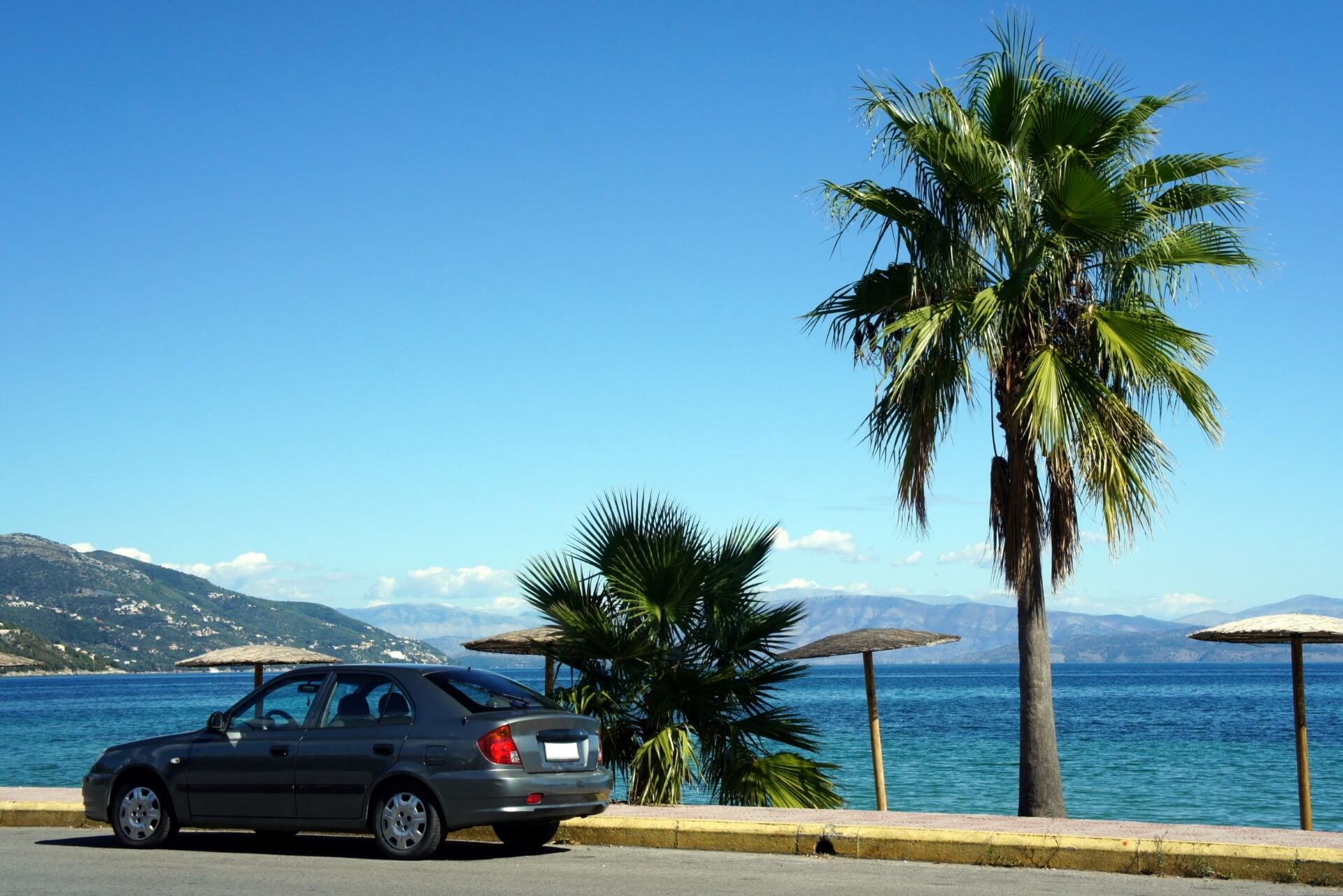
Traveling around the island of Corfu by car promises tourists a lot of unforgettable impressions. To make the vacation more extravagant and comfortable, you should use car rental services. The main advantage of a self-guided trip is the independence from tour routes, mobility, easy access to attractions, and the ability to see exotic places in a short time.
The island of Corfu is dotted with numerous picturesque villages filled with a special authentic atmosphere. Renting a car allows vacationers to reach the most secluded spots where mesmerizing landscapes reign. Traveling from north to west and then south, tourists will soak in the views of various natural landscapes, admiring them for as long as they wish.
Gouvia
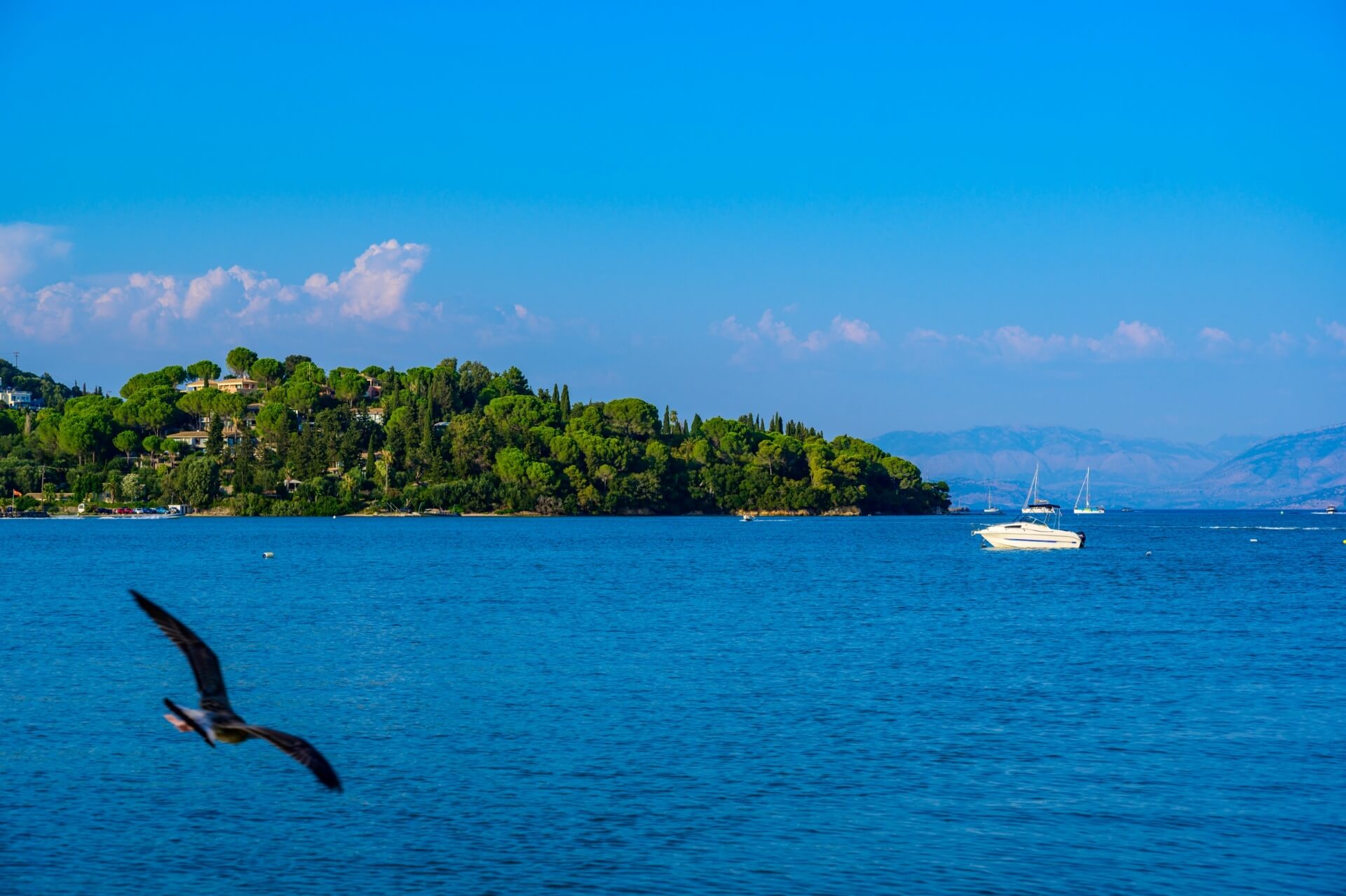
The modern resort of Gouvia occupies the eastern coast of Corfu. Once a thriving Venetian harbor, it is now a cozy bustling village located eight kilometers from the capital, Kerkyra. This picturesque corner attracts tourists with its magnificent nature: green hills, sheer cliffs, olive groves, lush forests, and the azure waters of the Ionian Sea.
In Gouvia, you can have a great time on both sandy and pebbly pristine beaches. For active holiday lovers, there are all kinds of water attractions that will bring a lot of positive emotions. Luxurious yachts and ships are moored in the calm bay. The tourist village has preserved many historical landmarks.
Among them, the majestic arches of the Venetian shipyard, where various ships were built and repaired in the early 18th century, stand out. A small white church rises on the shore of the bay. Visitors are warmly welcomed by numerous old Greek taverns.
Ipsos
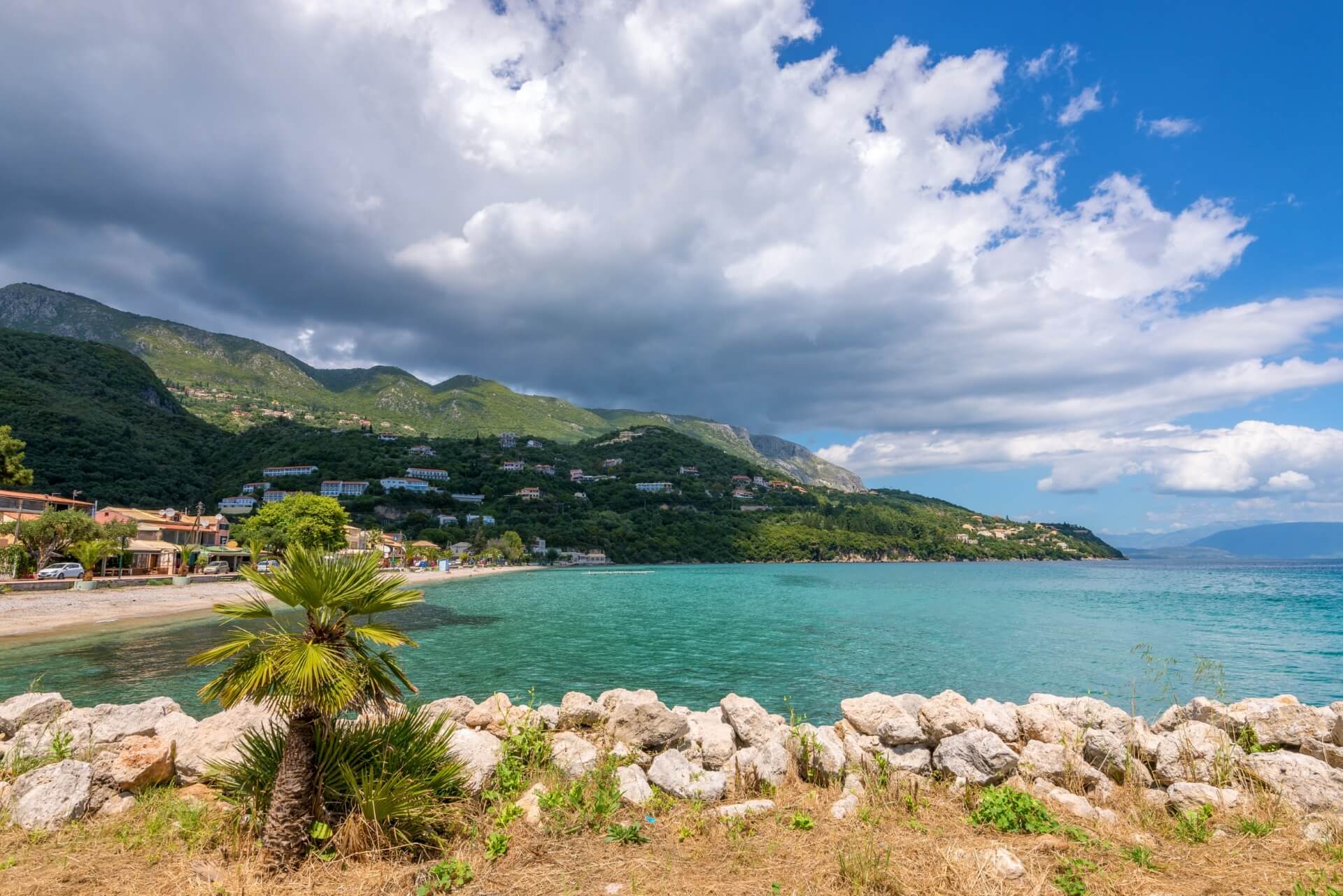
Along the stunning two-kilometer-long pebble-sandy beach, stretching near the main highway, lies the village of Ipsos. It is framed by mountain ranges, whose slopes are covered with emerald greenery of ancient olive groves. Orange and lemon trees fill the air with delightful citrus aromas.
Despite its small area, Ipsos has a well-developed infrastructure. There are hotel complexes, a bank branch, a shopping center, supermarkets, and rental points for any type of transport. The resort’s excellent coastline has earned it the “Blue Flag” award for the cleanliness of the sea bay and comfortable beach conditions.
Tourists have access to water attractions and sports grounds, taverns, bars, discos, and restaurants. The beach area is divided into sectors, so lovers of calm swimming and sunbathing do not feel discomfort from the proximity to proponents of active noisy recreation.
Kalami
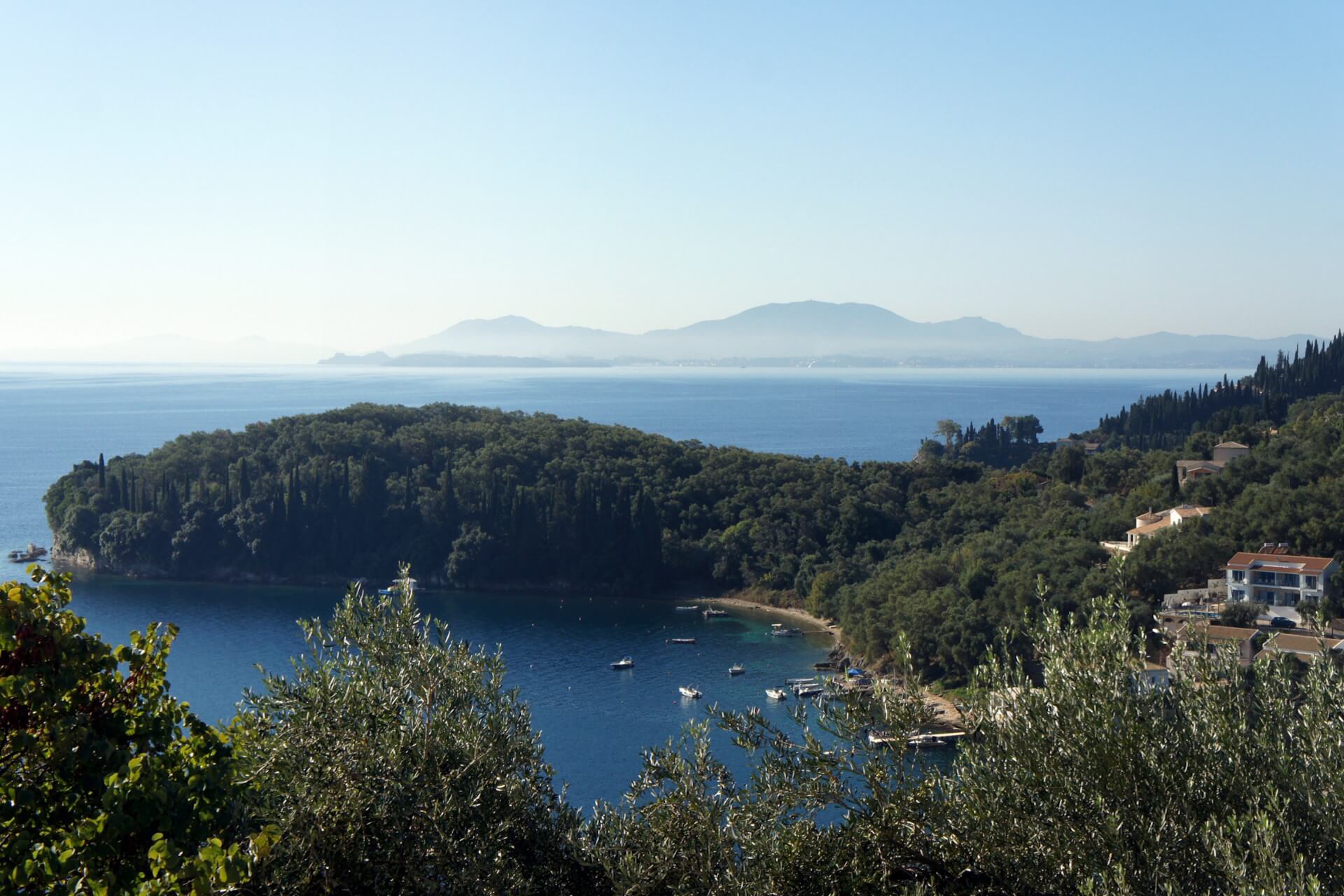
One of the most secluded and quiet places on the island of Corfu is the authentic town of Kalami. It is located 30 kilometers north of Kerkyra. The natural landscapes of the area are striking in their beauty and grooming. The coastline of the resort resembles an amphitheater, bordered on both sides by rocky outcrops. High hills with lush green vegetation protect the coastal strip of Kalami from cold winds and big waves of the azure Ionian Sea.
In Kalami, travelers can enjoy a peaceful, quiet holiday amidst pristine nature, away from the hustle and bustle of megacities. The crystal-clear bay and picturesque landscapes attract many vacationers. Leaving the car in a free public parking lot, tourists can take a walk to nearby beaches.
A mesmerizing panoramic view opens up from the hills to natural harbors surrounded by relic pines and firs. Guests have a wide range of sea entertainment: water skiing and pedal boating, yacht and boat trips, snorkeling. The shore is lined with taverns, bars, and shops.
Acharavi
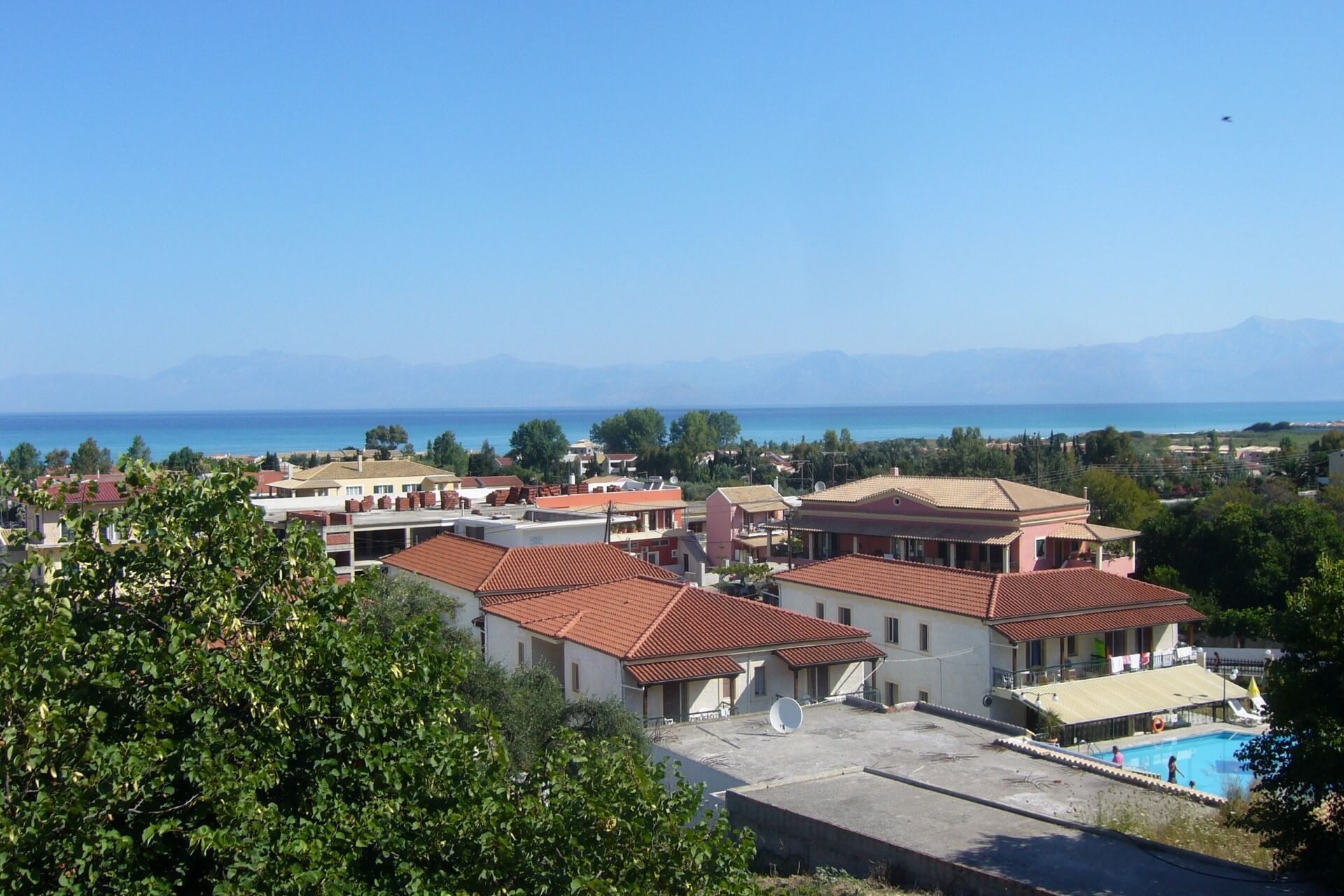
The village of Acharavi is located on a small flat area surrounded by mountain ranges. This wonderful resort corner is immersed in the greenery of pomegranate, almond, and orange trees. Along the extensive coastline, washed by the warm waters of the Ionian Sea, lies the main street with various hotels, restaurants, souvenir shops, and entertainment venues.
The main attraction for tourists is the seven-kilometer beach, covered with golden sand and fine pebbles. There is everything necessary for a full and first-class vacation. The shore is equipped with resort accessories: sun loungers, shade canopies, showers, and changing rooms. In the coastal taverns, you can try local cuisine and quench your thirst with refreshing drinks.
Pantokrator
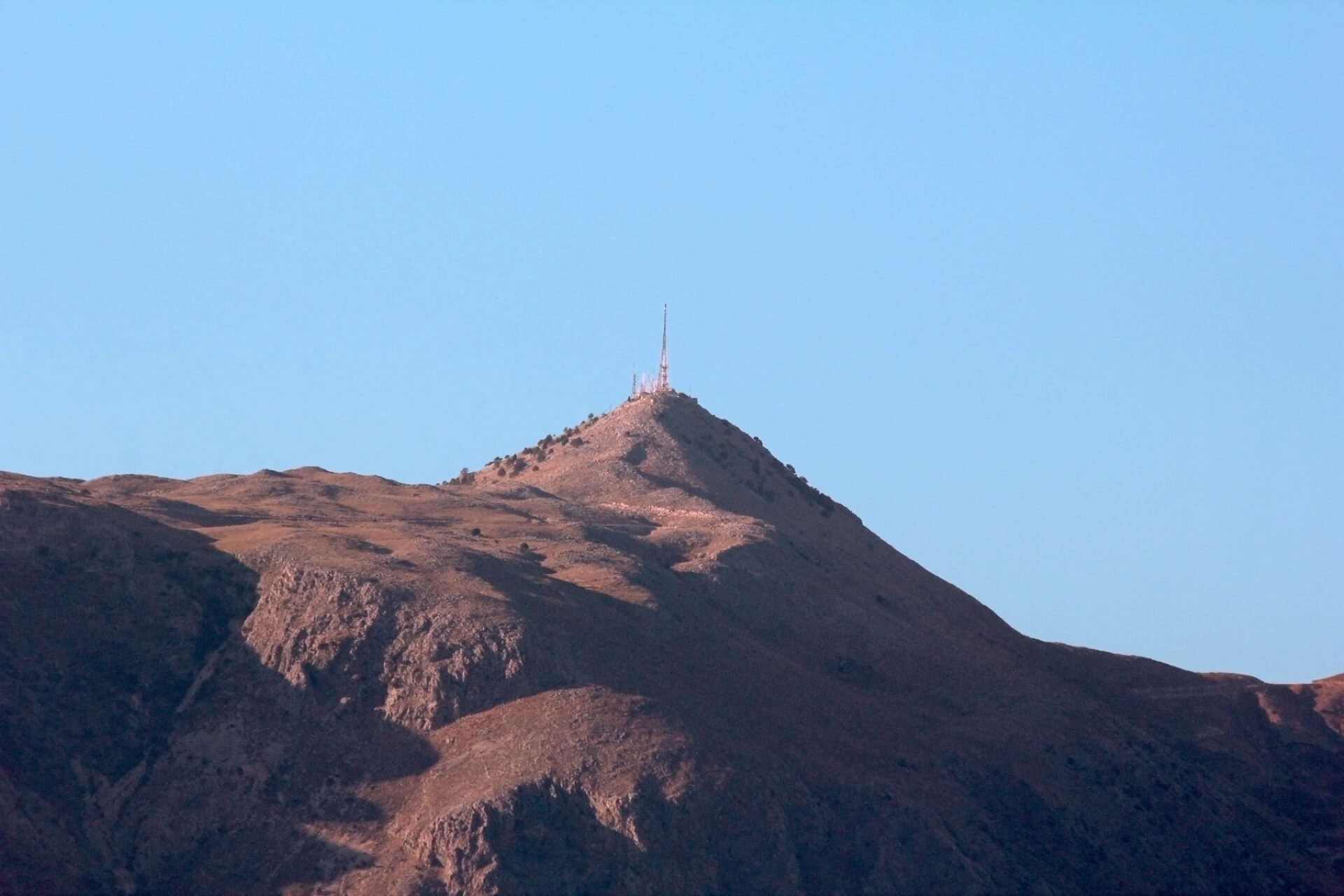
One of the most popular attractions in the northern part of Corfu is the majestic Mount Pantokrator. Its height is about 900 meters above sea level. From the top of the mountain ridge, there is a stunning panoramic view of the island’s surroundings, the azure sea bay, and the nearby coast of Albania. The viewing radius exceeds 130 kilometers. Climbing Pantokrator will leave bright memorable impressions from the trip.
A narrow winding road with steep climbs leads to the highest point of Corfu. Overcoming the challenging and long path, tourists will be greeted by amazing landscapes, as well as a telecommunications tower and an old monastery. The monastery, which has survived to this day, was built in the 17th century. The monastery buildings are made of gray stone without architectural frills. The monastery’s church is of interest. Its walls and ceiling are decorated with colorful frescoes.
Perithia

At the foot of mountain ranges lies the semi-abandoned village of Perithia. This oldest settlement on the island of Corfu was founded in the 14th century. The village served as a safe haven from pirate raids. The sea bay is perfectly visible from here, while Perithia itself cannot be seen from the coast.
History lovers can soak up the medieval atmosphere in this highland village. Ancient buildings and churches have been preserved here. Many buildings have long turned into ruins. But against the backdrop of picturesque landscapes, a special sense of delight arises. Tourists will walk past dilapidated houses with boarded-up shutters and collapsed roofs.
Old stone masonry houses are overgrown with bushes and trees. Walking along the deserted paths among the abandoned buildings, guests of Perithia unexpectedly discover numerous taverns. The few local residents of the village are mainly engaged in sheep farming and beekeeping.
Sidari

A picturesque winding highway, running through green hills, will lead car travelers to the popular resort of Sidari. This vibrant corner boasts a main street full of snack bars, bars, nightclubs, and taverns along the coastline. Olive groves, oak forests, and cypress plantations grow along the alleys.
Cozy bays with white sandy beaches and turquoise sea bays are a valuable natural treasure of Sidari. Numerous tourists are attracted by the unique coastline, framed by high sandstone capes. The bizarre shapes of the cliff formations, created by weathering, have formed a unique and amazing landscape.
The sandstones stretching 300 meters into the sea form a narrow channel between them. The coastline is dotted with grottoes and natural sculptures washed out of the soft mountain rock by water. The beach area is equipped with all resort amenities. Tourists are offered a wide range of entertainment options to suit all tastes. These include water sports, sea trips, diving, and much more.
Paleokastritsa
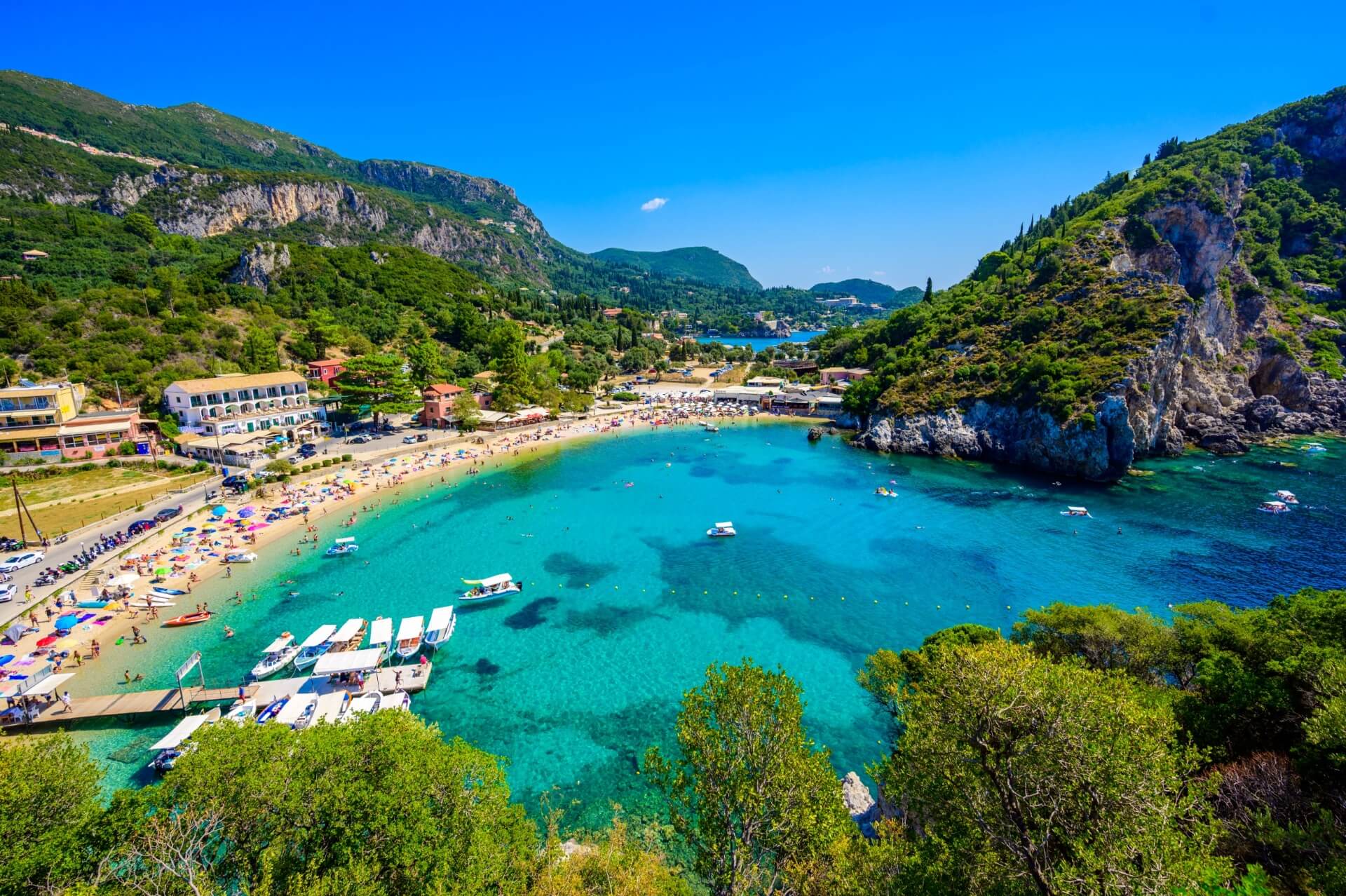
The expressive gem of Corfu is the village of Paleokastritsa, located 25 kilometers from Kerkyra. This resort corner is famous for its magnificent landscapes, admiration of which leaves an indelible impression. Sheer cliffs descending to the turquoise bays of the Ionian Sea create a cascade of cozy bays with golden sandy beaches.
The slopes of the mountains are covered with dense and lush pine vegetation, creating a delightful picture for lovers of mesmerizing nature. The resort has a well-developed hotel infrastructure. There are wonderful restaurants and taverns here, serving traditional Greek dishes. Vacationers can take a sea trip along the coastline, indented with majestic rocky cliffs.
On one of the village’s hilltops stands the active men’s monastery of Theotokos, founded in the 13th century. The monastery grounds house a museum exhibiting icons adorned with precious stones and Orthodox church artifacts. From the monastery garden’s observation deck, there is a wonderful view of the vast sea expanse and towering cliffs.
Corfu Ultimate Guide: 15 Best Attractions
Lakones
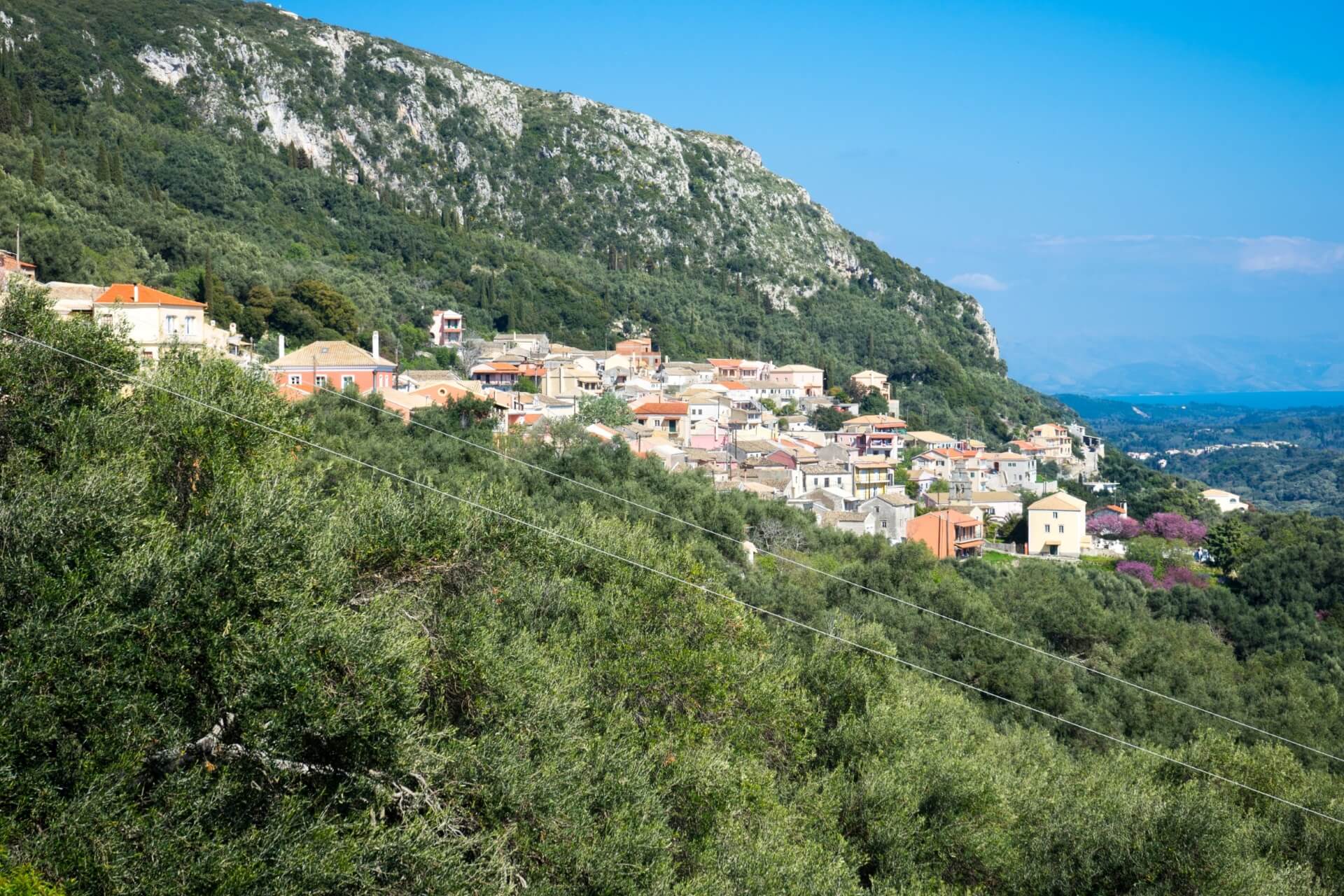
Parking the car in Paleokastritsa, travelers can embark on a hiking expedition towards the village of Lakones. It is located at an elevation of 400 meters above sea level. The fascinating route runs through olive groves, flower gardens, wooded areas, and a rocky gorge. Upon reaching the destination, tourists will face a maze of narrow streets.
Numerous old buildings are literally scattered along the slope, immersed in the greenery of Mediterranean vegetation.
The roads along the houses, built in the 18th-19th centuries, lead to the central square of the village. The main attraction is the Lakones observation deck. From the highest point, stunning views and excellent panoramas of the sea bay with rocky coves open up. The Paleokastritsa monastery, surrounded by green hills, is clearly visible from here.
Angelokastro
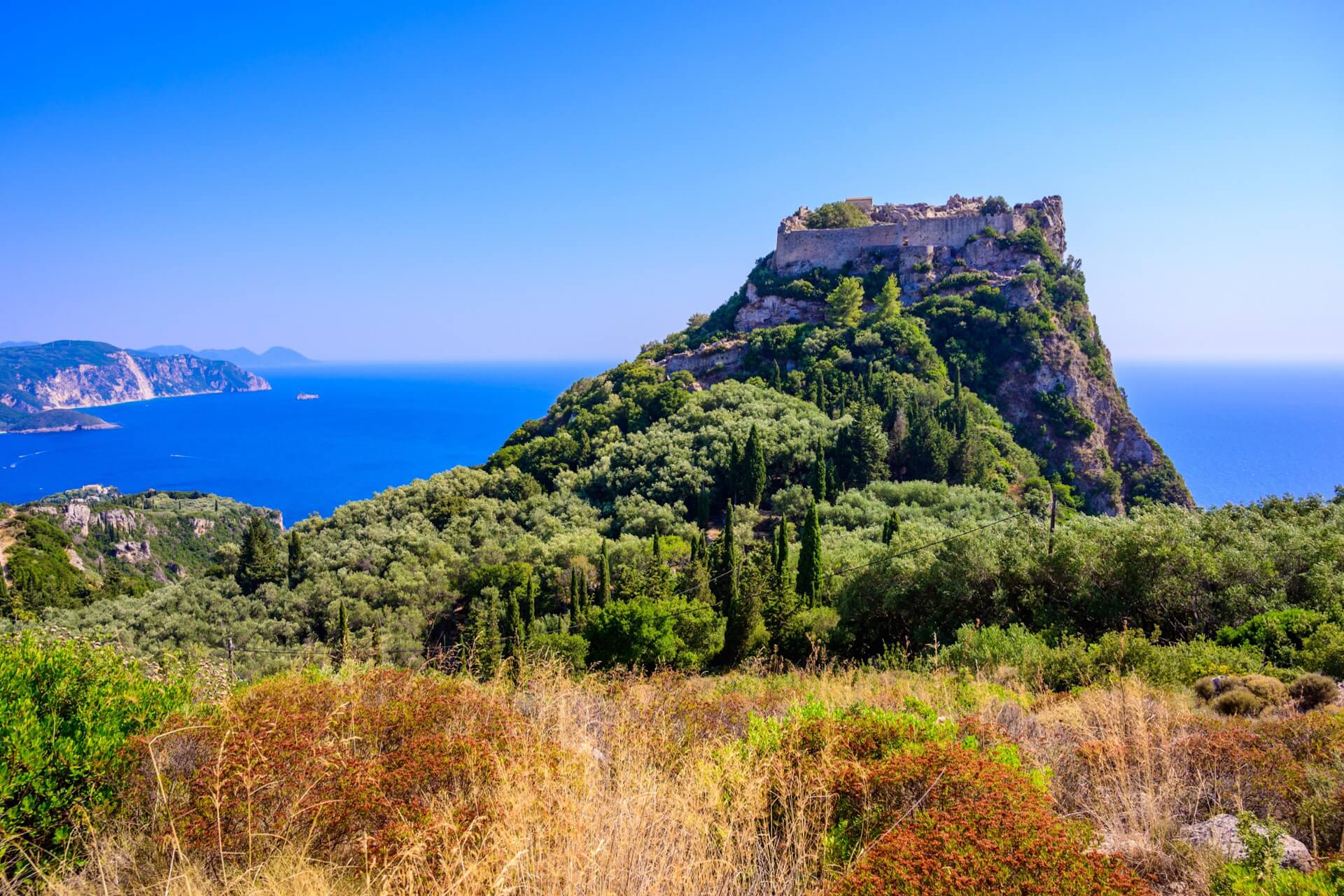
At the top of a sheer cliff on the resort coast of Paleokastritsa stands an impressive monument of medieval architecture – the Byzantine castle of Angelokastro. The height of the cliff on which the fortress stands is about 300 meters above sea level. Once an impregnable fortress, built in the 13th century, it held a strategically significant position for many centuries.
It served as the island of Corfu’s defense against pirate raids and steadfastly withstood enemy attacks. The fortification represented a fortified citadel with powerful walls, loopholes, towers, and underground passages. Today, the castle is in a semi-ruined state. Tourists can take an interesting walk through the grounds of Angelokastro.
Here you can see water cisterns, ruins of buildings and towers, as well as two old chapels with frescoes and icons. The fortress walls offer breathtaking views of the turquoise-blue sea expanses, hills with emerald greenery, and the coast of Corfu. Independent tourists can reach the castle by car along a narrow serpentine road. A parking lot is equipped at the foot of the cliff. A gentle stone staircase leads through olive groves to the main gates of the fortress.
Agios Georgios (West)
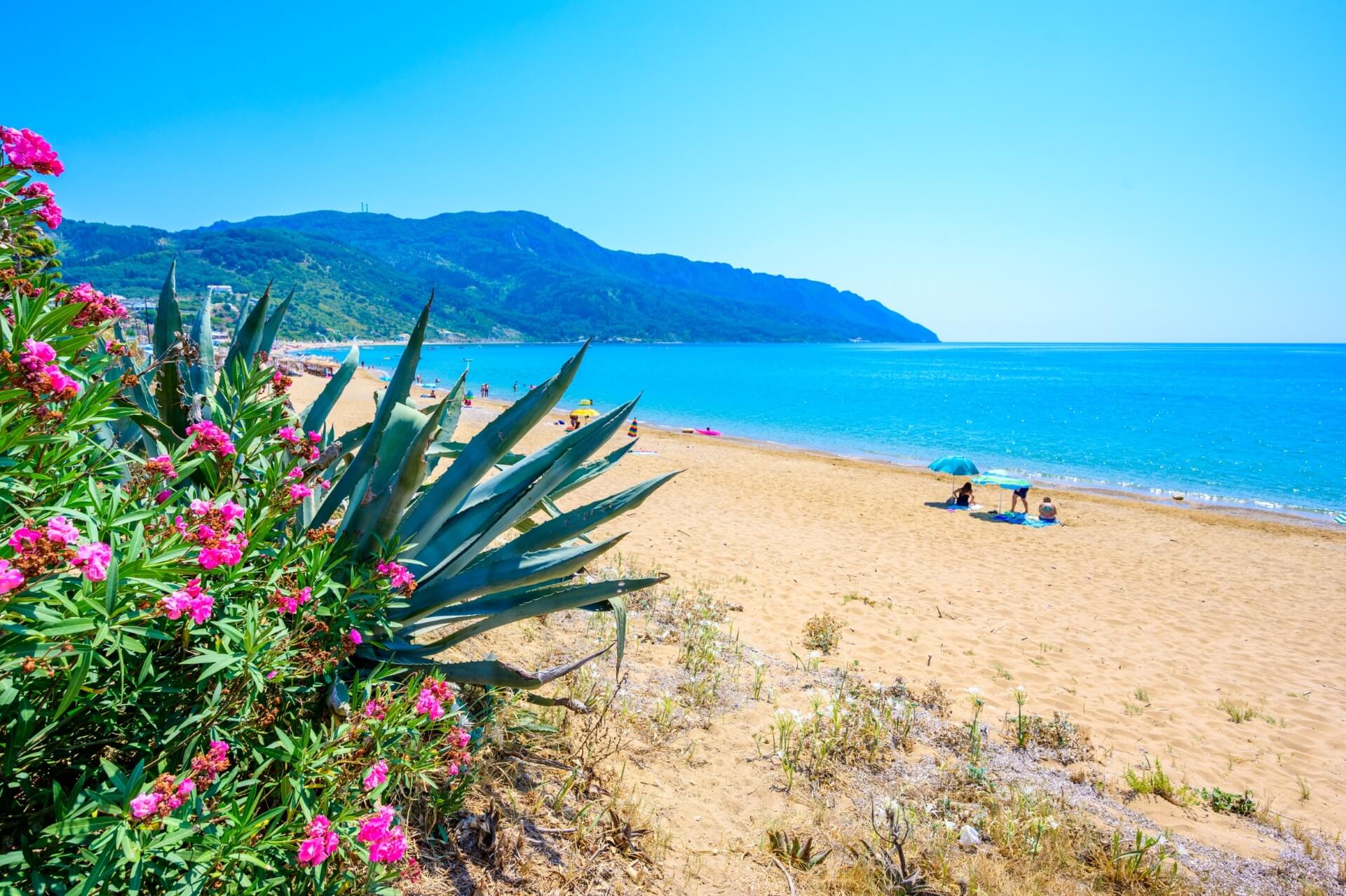
The resort village of Agios Georgios occupies the northwestern part of Corfu. This Greek resort corner is perfect for lovers of peaceful and secluded relaxation amidst pristine, stunning nature. There are no significant attractions or noisy entertainment venues here, allowing tourists to fully enjoy the calm atmosphere on the stunning coastline.
The extensive coast of the resort is covered with golden velvety sand. The beach is surrounded by green hills and pine groves. The emerald bay of the Ionian Sea is striking in its crystal-clear water and transparency. The entrance to the water is gentle.
The sandy seabed is free of stones. Tourists are offered sun loungers and parasols, as well as opportunities to engage in various water sports. Lovers of secluded quiet relaxation can settle on “wild” sections of the shore where there are no beach amenities. Beachgoers can use the services of a tavern and cafe.
Afionas
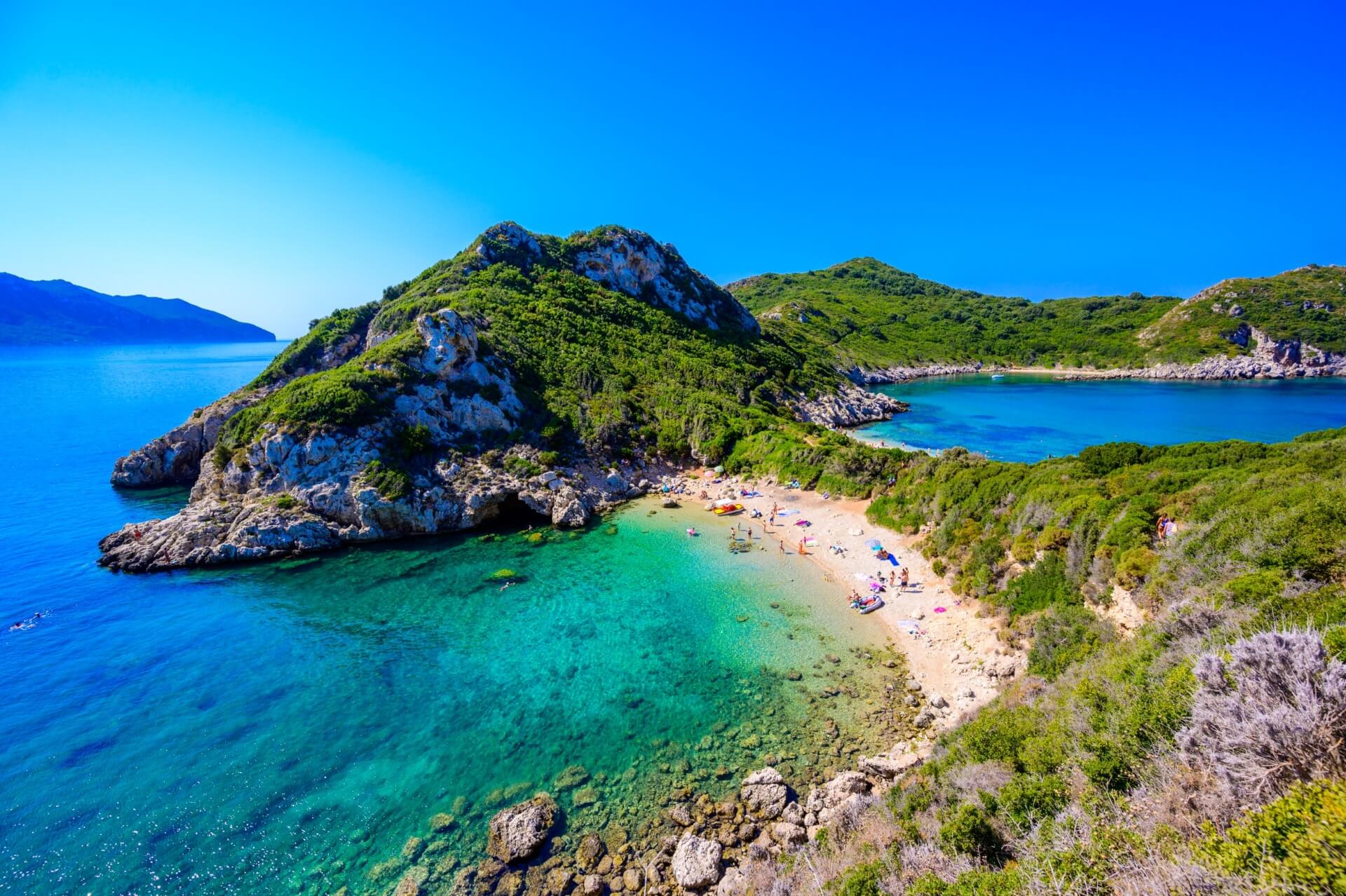
The picturesque village of Afionas, located on the edge of a rocky cape of a small peninsula on Corfu’s northwestern coast, is worth a visit. The village is built so that stunning views open up from all sides. The azure sea bay, green hills, and majestic rocky formations give the area an unmatched charm.
Afionas welcomes its guests with a maze of narrow streets with romantic courtyards, literally immersed in flower gardens. The white facades of ancient stone houses are adorned with blue shutters and doors. In the village’s central square stands a chapel. One of the picturesque paths leads to a double bay with turquoise waters.
Benitses
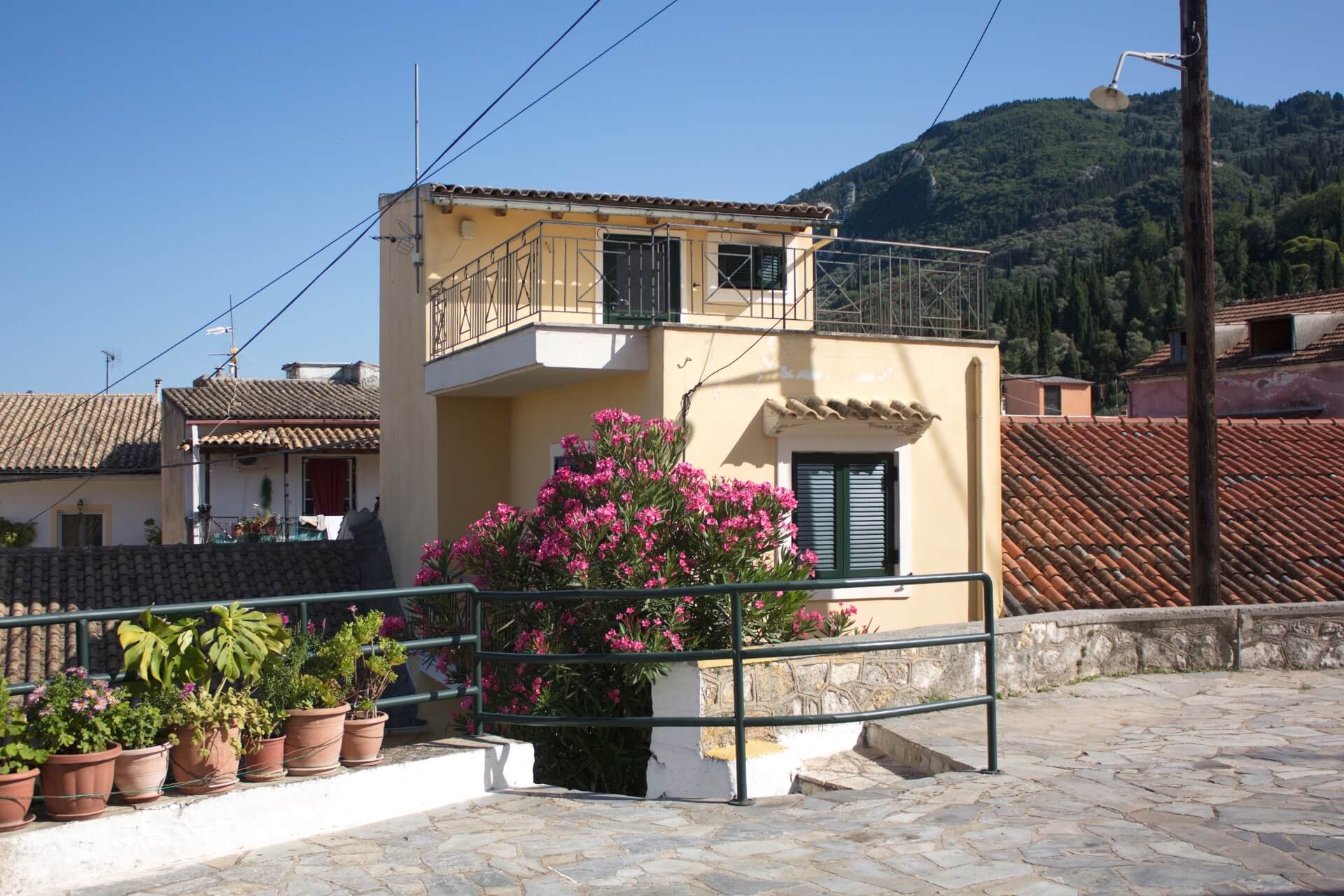
The town of Benitses is surrounded by majestic mountains covered with lush vegetation. Tourists seeking a break from the noise and bustle flock here. The resort has a well-developed infrastructure. Cozy streets are lined with shop windows and signs of stores, restaurants, and supermarkets. Along the embankment are hotels and guesthouses. The local pebble beach has been awarded the “Blue Flag” for its crystal-clear sea bay and clean shore.
The coast is equipped with all the amenities for a comfortable stay. In Benitses, you can appreciate the exhibits of the marine museum, which houses an impressive collection of shells, stuffed marine creatures, fossils, and corals. The resort also preserves the ruins of ancient Roman baths dating back to the 3rd century BC.
Art and sculpture enthusiasts should visit the Achilleion Palace complex. It is located in the village’s surroundings, making it easy to reach by car. The palace halls display paintings and sculptures depicting scenes from the myths of famous “Iliad” heroes. Luxurious interior elements attract attention: painted ceilings, elegant vases, and Doric columns. The mansion houses rare pieces of furniture and 19th-century jewelry.
Messonghi
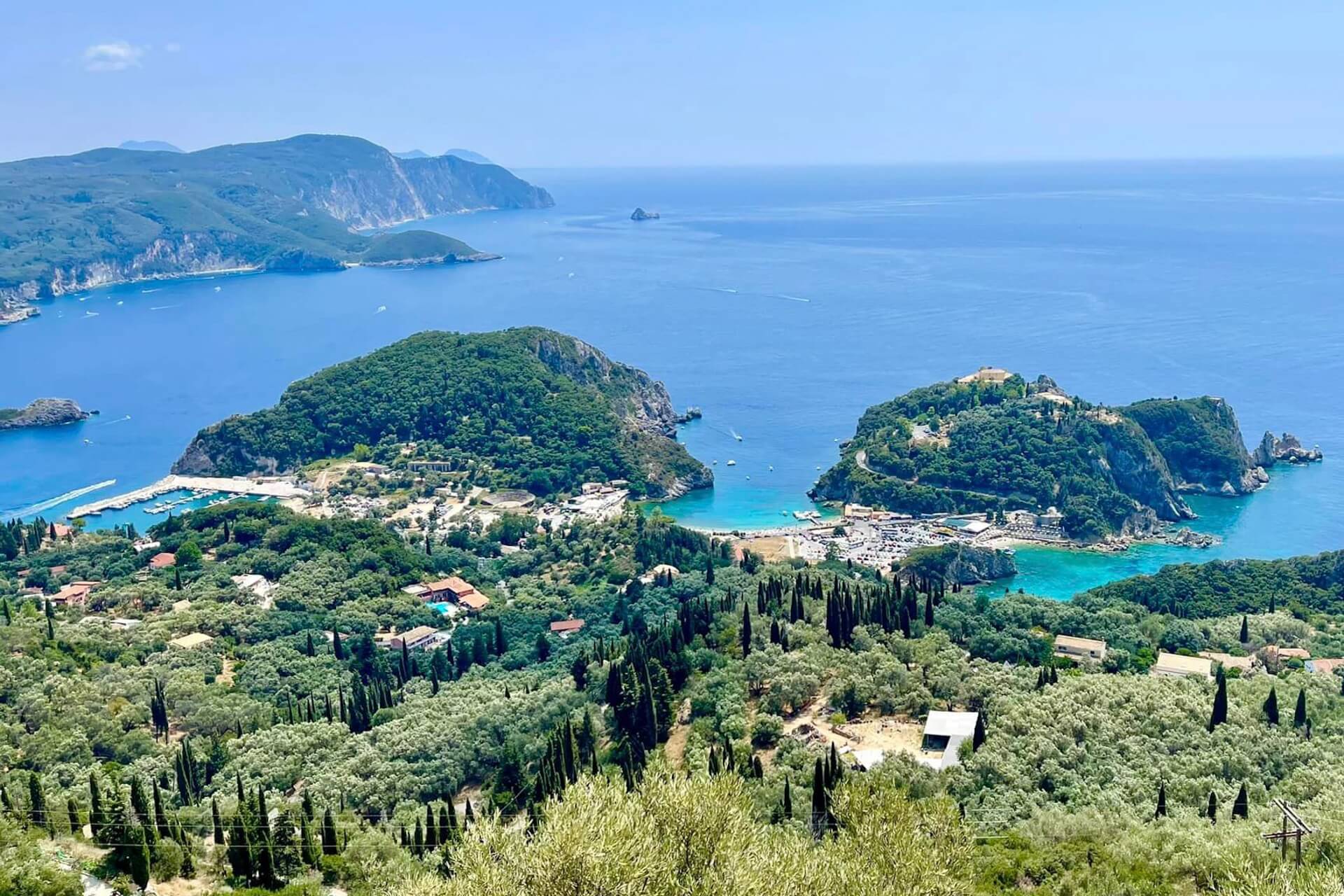
The village of Messonghi warmly welcomes its guests. The resort occupies a flat area dotted with olive groves and other Mediterranean plants. The Greek town is a peaceful place with everything needed for a harmonious, comfortable stay. The village has hotels, bars, taverns, and various stores.
The wide sandy beach is the main asset of Messonghi. The coastline has been awarded the UNESCO “Blue Flag” and boasts a well-developed infrastructure. The long shallow waters and gentle descent into the water allow young and adult vacationers to fully enjoy swimming in the warm aquamarine sea bay.
Entertainment programs include water skiing and pedal boating, banana boat rides, boat trips, and diving. Four kilometers from Messonghi are the ruins of the ancient Byzantine fortress of Gardiki. The octagonal structure with mighty fortifications dates back to the 13th century. The ruins of the citadel and the remains of a stone chapel are of interest.
Lefkimmi
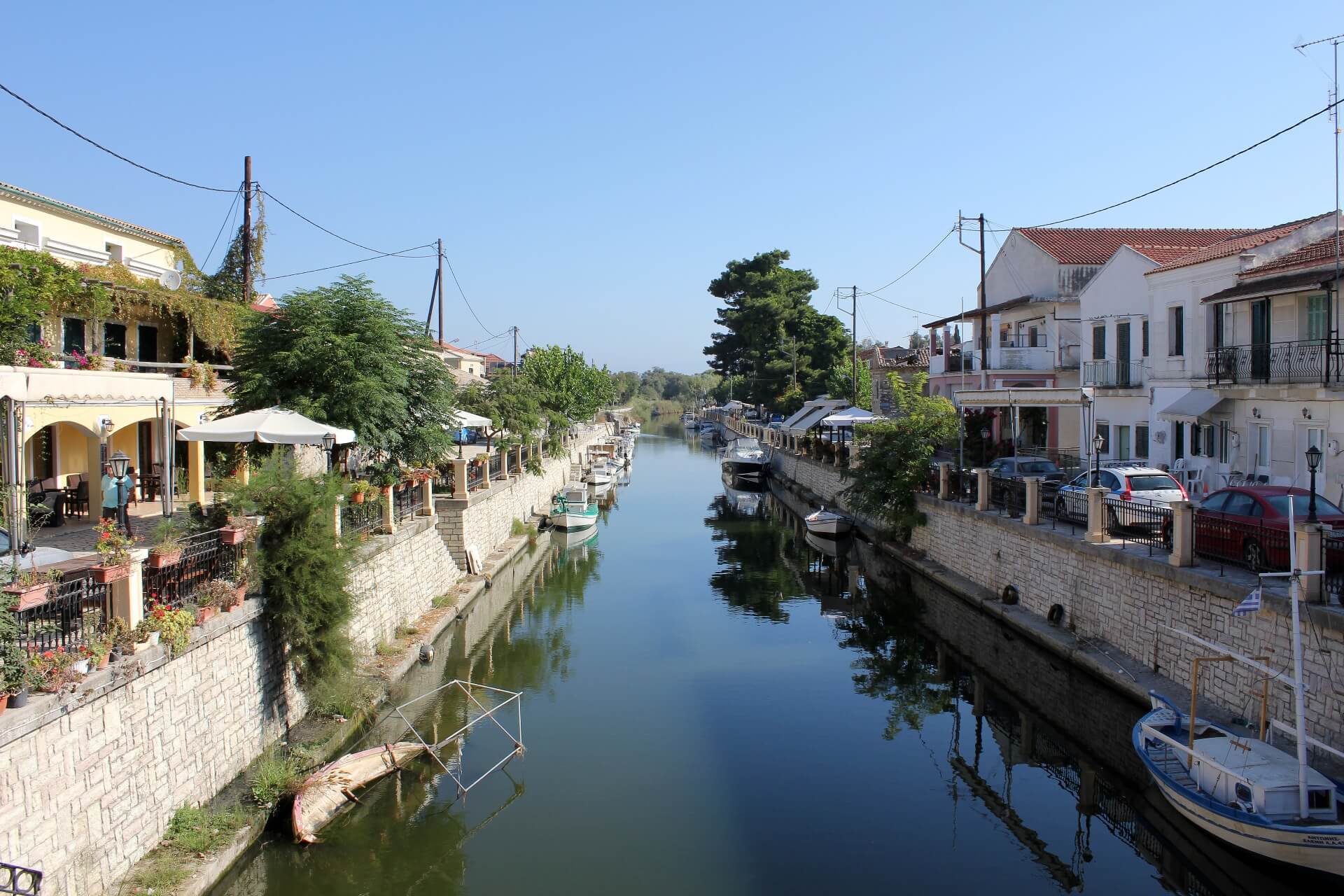
Lefkimmi is a fertile flat gem in the southern part of Corfu. A trip to this town offers tourists the chance to get acquainted with the traditional Greek way of life. The picturesque quarters with ancient stone houses and old churches exude an unmatched atmosphere.
Cedar forests and olive groves provide refreshing coolness on a hot day. Narrow quiet streets are lined with orange trees and fragrant flower gardens. A narrow canal runs through Lefkimmi, connecting a lake with the Ionian Sea.
Along it are cozy taverns where hospitable hosts treat visitors to homemade dishes of national cuisine. Walking through the town, travelers can see several old churches. The church of Agii Anargyri with its two tall bell towers attracts attention. The majestic orange dome of the Agios Arsenios sanctuary is also of interest.
Kavos
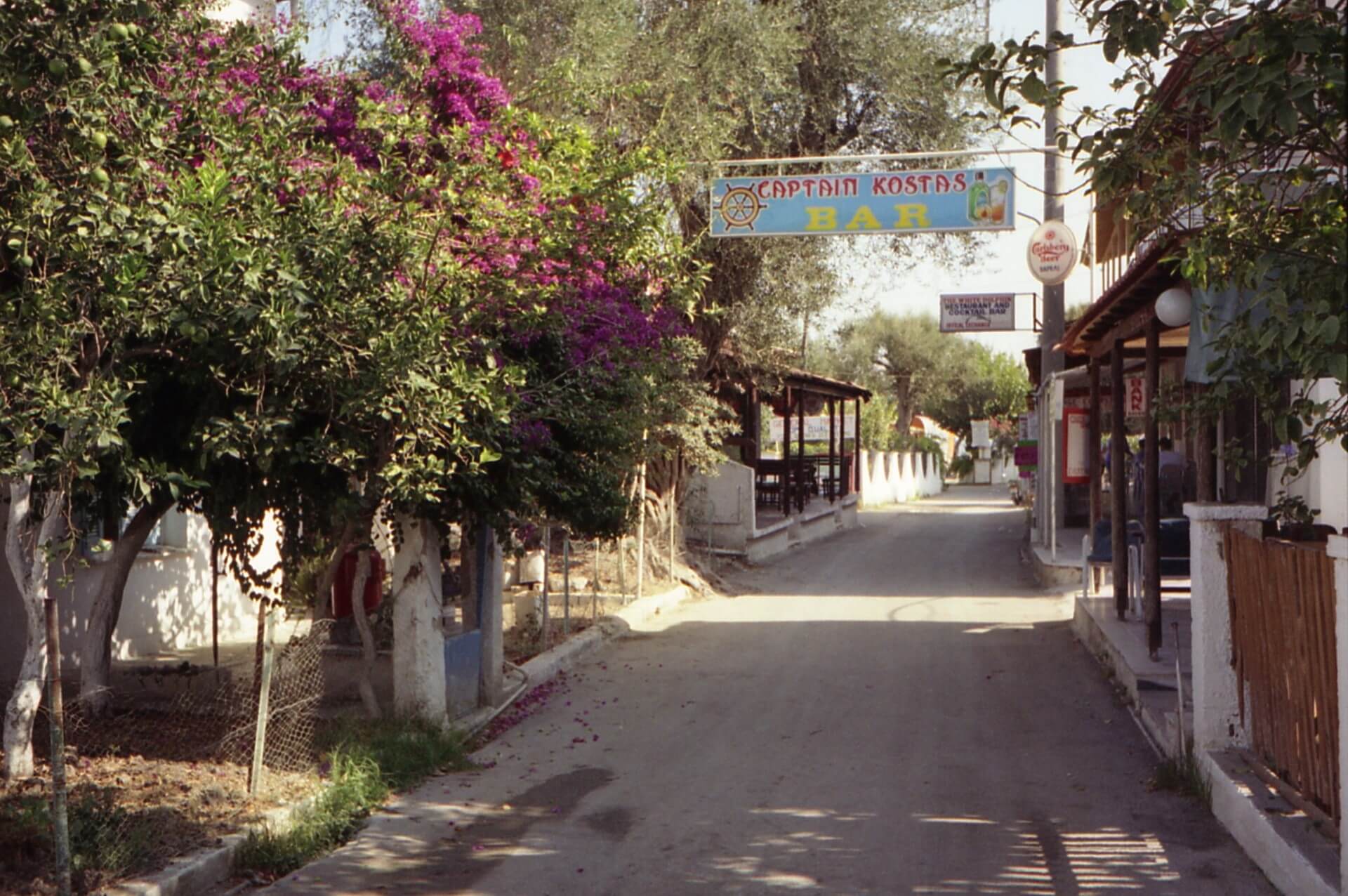
At the southern tip of Corfu is the popular resort of Kavos. It occupies a moderately hilly area surrounded by picturesque landscapes. Rocky shores, olive groves, pine and citrus trees leave an indelible impression.
The area is aimed at lovers of active pastimes and wild nightlife. Numerous clubs, bars, restaurants, and discos are concentrated here. Prestigious dance floors host lively parties with internationally renowned DJs.
Kavos does not have historical and cultural attractions. The resort’s highlight is a long and narrow sandy strip. It stretches for several hundred meters and ends with countless wild bays. The central part of the beach offers vacationers various water attractions. The warm shallow bay of the Ionian Sea contributes to Kavos’s popularity.
Agios Georgios (South)
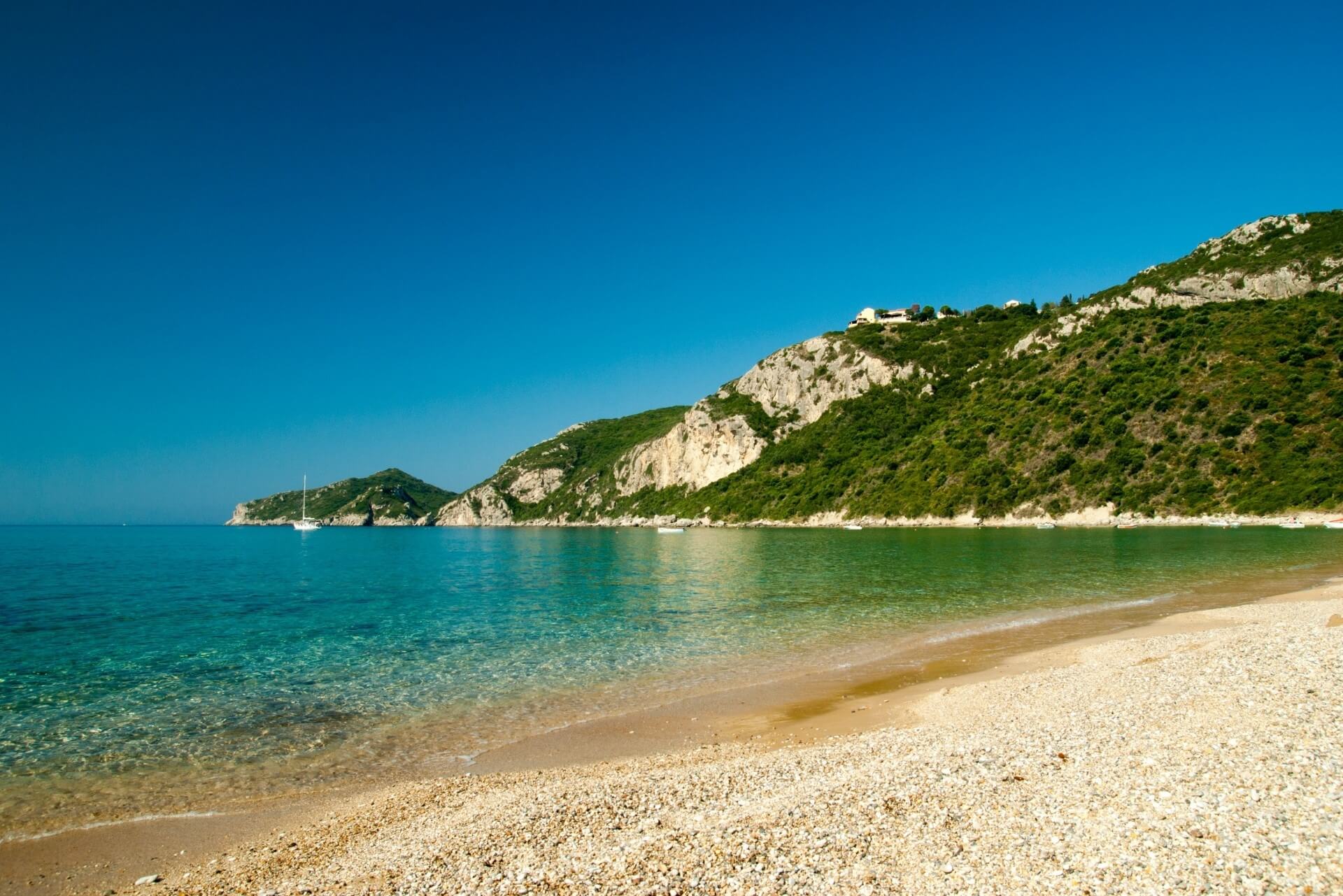
The resort town of Agios Georgios is famous for its wide velvet-sand beach. It stretches between two rocky capes 30 kilometers south of Kerkyra. The village is popular among families with children, couples, and lovers of peaceful relaxation. There is a wide choice of star-rated hotels. There are many bars, taverns, and various shops here.
First of all, car travelers are advised to head to the coast, washed by the crystal-clear waters of the Ionian Sea. The coastline has been awarded the honorary symbol “Blue Flag.” Vacationers have access to a well-developed beach infrastructure: sun loungers, umbrellas, changing rooms, showers, and water attractions. After swimming in the aquamarine bay and sunbathing, tourists can enjoy culinary masterpieces in one of the local traditional restaurants.
Lake Korission
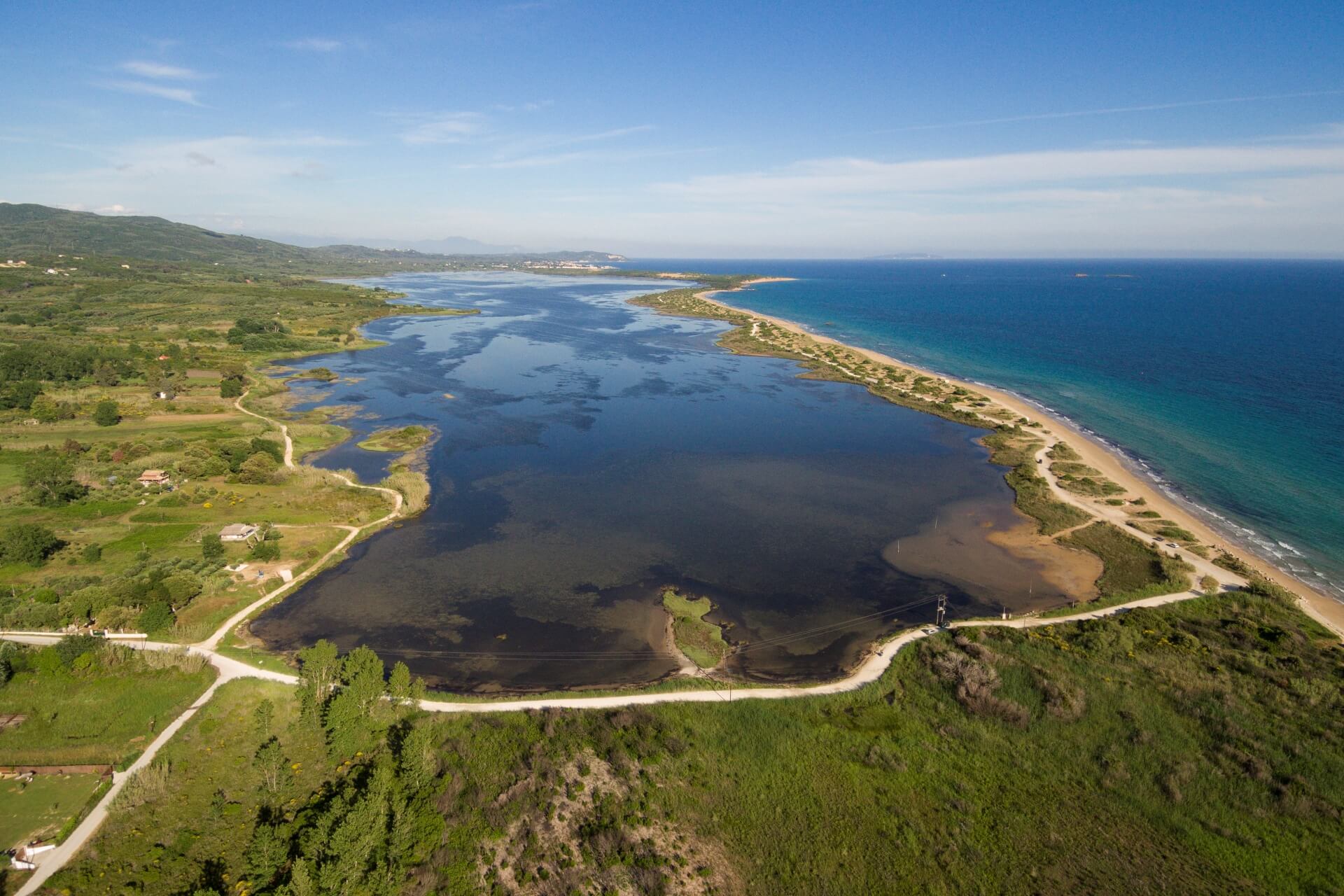
The program of an exciting car trip around Corfu should include a visit to Lake Korission. You can reach it by car, driving about 30 kilometers southwest of Kerkyra. The picturesque freshwater pond is separated from the sea bay by a narrow sandy strip.
The reservoir and its surroundings are an amazing ecosystem. Velvet dunes, local flora, and fauna create wonderful conditions for a stroll in pristine nature. The lake’s shores are covered with cedar and juniper forests, as well as thickets of various wild plants: dense grasses and shrubs.
This amazing spot is favored by white herons, pink flamingos, ibises, ducks, turtles, and lizards. A beach area is set up on the sandbar between the sea and the lake, where tourists can enjoy a secluded holiday. Swimming is only allowed in the azure sea bay. Bathing in the lake is prohibited.
Agios Mattheos
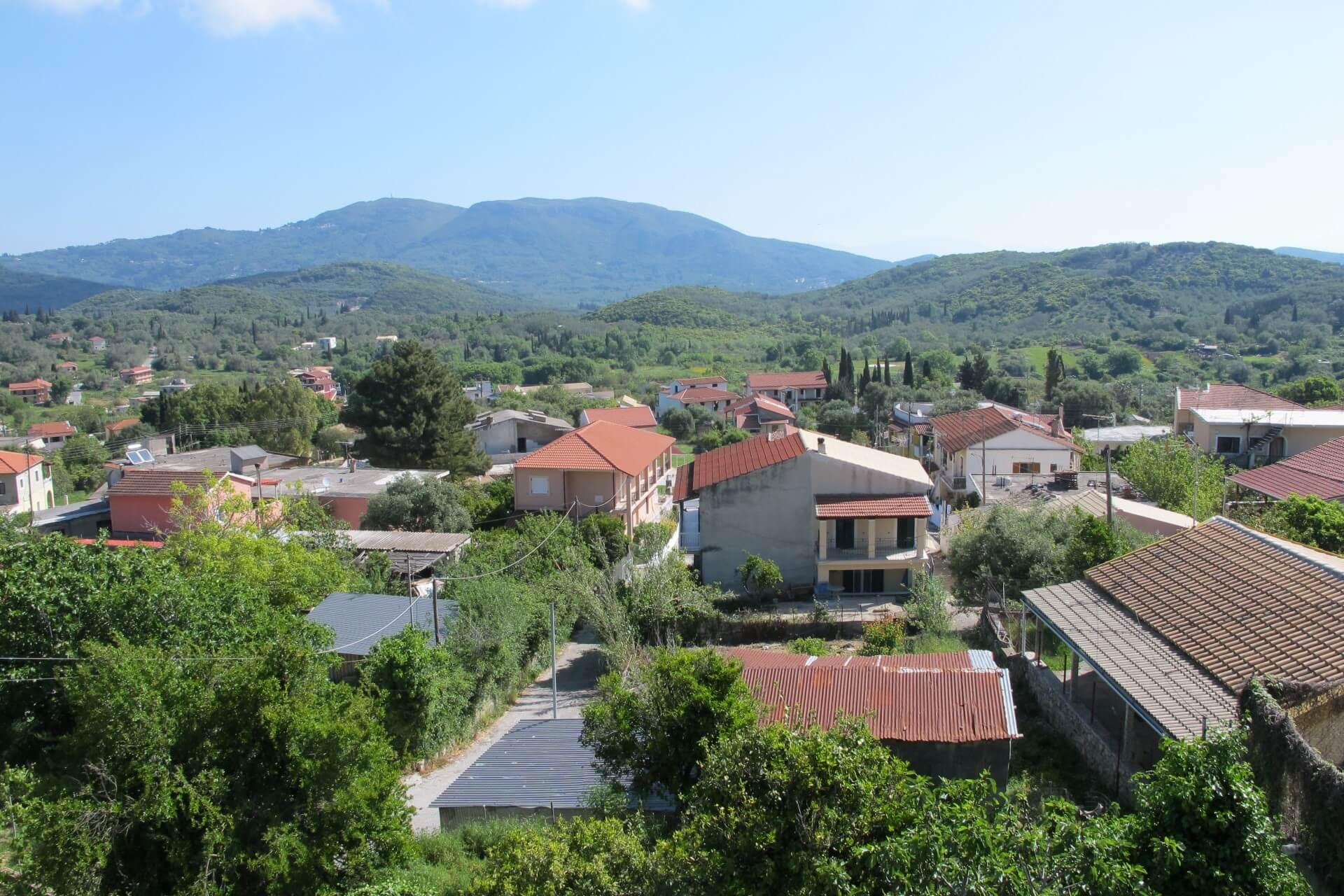
In the small mountain village of Agios Mattheos, a special atmosphere of antiquity reigns. The village is surrounded by a dense forest and stands on a hillside. Here, time seems to have stopped, allowing tourists to soak up the authentic lifestyle of the local population. Narrow streets are densely built up with old houses.
From all corners of the village, the tall bell tower of the church, symbolizing the centuries-old spiritual heritage of the local population, can be seen from afar. The residents of Agios Mattheos sell various eco-friendly products of their own production. These include jams, honey, dried fruits, preserves, olive oil, and homemade preserves.
The village is surrounded by a calm coastline, free from crowds of noisy vacationers. A magnificent beach is covered with soft white sand. The entrance to the emerald sea bay is quite gentle. Travelers are advised to stay on the shore until sunset. At this time, stunning evening scenes of peaceful landscapes arise. The sun setting over the horizon paints the area in shades of pink.
Pelekas
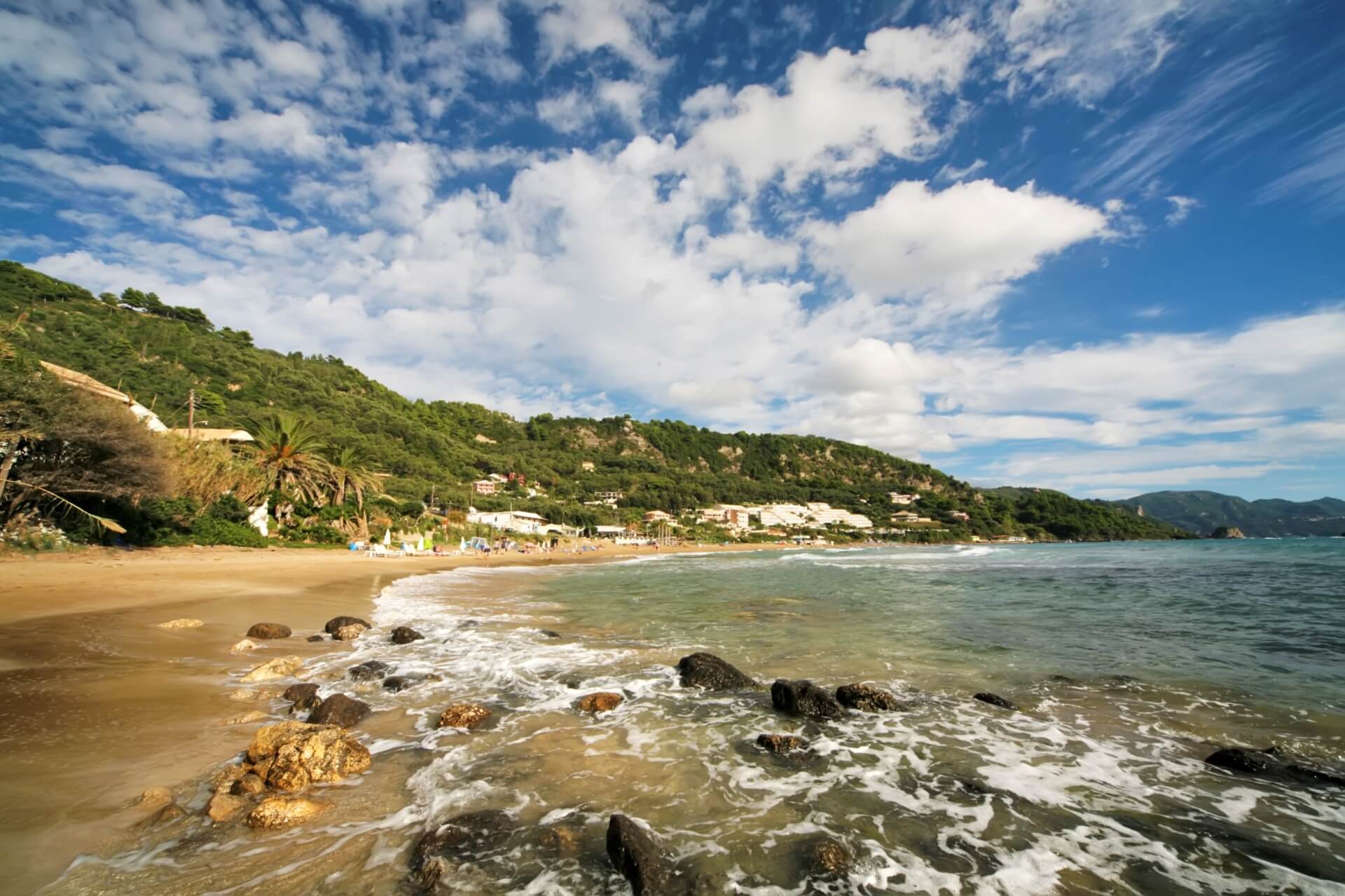
At an altitude of 270 meters above sea level lies the traditional Corfiot village of Pelekas. It occupies a picturesque green valley near one of the island’s many hills. In this small town, tourists can fully appreciate the national color of Greece and soak up the spirit of sunny Corfu.
There are no historical landmarks here, but a walk along the white trails of narrow streets with ancient stone houses and small chapels will leave no one indifferent. The village of Pelekas gained wide popularity thanks to the observation deck – the “Kaiser’s Throne.” This was the favorite spot of German Emperor Wilhelm II. He regularly came here to climb to the top of the rock and admire the stunning panorama of Corfu.

